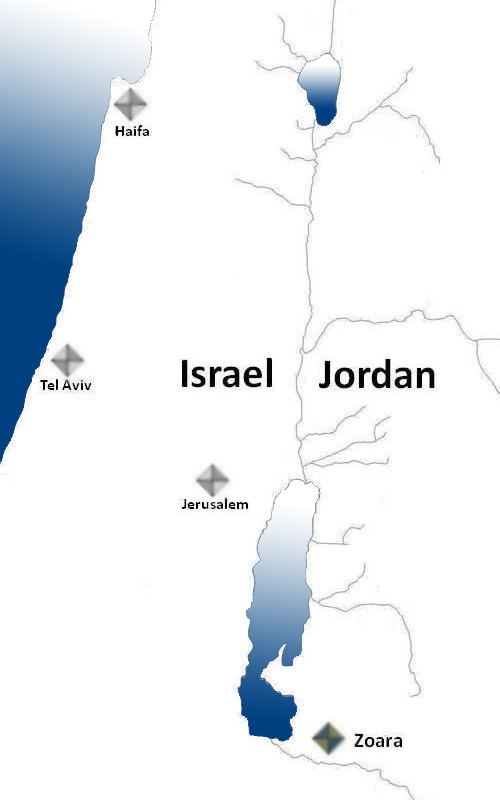 | ||
Weather 16°C, Wind S at 5 km/h, 67% Humidity | ||
Zoara, the biblical Zoar, previously called Bela (Genesis 14:8), was one of the five "cities of the plain" - a pentapolis apparently located along the lower Jordan Valley and the Dead Sea plain and mentioned in the Book of Genesis. It was said to have been spared the "brimstone and fire" which destroyed Sodom and Gomorrah in order to provide a refuge for Lot and his daughters. It is mentioned by Josephus; Ptolemy (V, xvi, 4); and by Eusebius and Saint Jerome in the Onomasticon.
Contents
Owing to the waters coming down from the mountains of Moab, Zoara was said to be a flourishing oasis where the balsam, indigo, and date trees bloomed luxuriantly.
In the Bible
Zoara-, meaning "small" or "insignificance" in Hebrew (a "little one" as Lot called it), was a city east of Jordan in the vale of Siddim, near the Dead Sea. Along with Sodom, Gomorrah, Admah, and Zeboim, Zoar was one of the 5 cities slated for destruction by God; but Zoar was spared at Lot's plea as his place of refuge (Genesis 19:20-23). Segor is the Septuagint form of "Zoar".
Bishopric
Zoara was part of the late Roman province of Palaestina Tertia.
It became a bishopric and is included in the Catholic Church's list of titular sees.
Le Quien gives the names of three of its bishops;
Archaeology
Prior to the major archaeological excavations in the 1980s and 1990s that took place in Zoara, scholars proposed that several sites in the area of Khirbet Sheikh 'Isa and al-Naq' offered further evidence of Zoara's location and history. Further information regarding Zoara in different historical epochs were obtained through the descriptions of Arabian geographers, suggesting that Zoara served as an important station in the Aqaba-to-Jericho trade route, and through Eusebius' statement that the Dead Sea was situated between Zoar and Jericho. Researchers who have studied ancient texts portray Zoara as a town erected in the middle of a flourishing oasis, watered by rivers flowing down from the high Moab Mountains in the east. The sweet dates that grew abundantly on the palm trees surrounding Zoara are also mentioned in some historical texts.
Several excavation surveys have been conducted in this area in the years 1986-1996. Ruins of a basilical church that were discovered in the site of Deir 'Ain 'Abata ("Monastery at the Abata Spring" in Arabic), were identified as the Sanctuary of Agios (Saint) Lot. An adjacent cave is ascribed as the location where Lot and his daughters took refuge during the destruction of Sodom. About 300 engraved funerary steles in the Khirbet Sheikh 'Isa area in Ghor as-Safi were found in 1995. Most gravestones were inscribed in Greek and thus attributed to Christian burials, while several stones were inscribed in Aramaic, suggesting that they belong to Jewish burials. Of these, two inscriptions reveal the origins of the deceased as being Jews that hailed from Ḥimyar (now Yemen) and which funerary inscriptions date back to 470 and 477 A.D., written in the combined Hebrew, Aramaic and Sabaean scripts. In one of them it was noted that the deceased was brought from Ẓafār, the capital of the Kingdom of Ḥimyar, to be buried in Zoar. These gravestones have all been traced back to the fourth-fifth centuries A.D., when Zoara was an important Jewish center.
